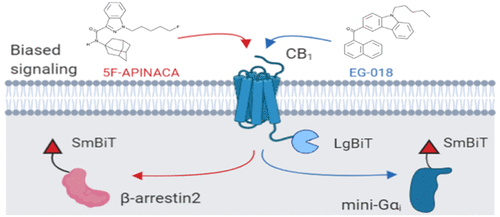当前位置:
X-MOL 学术
›
ACS Pharmacol. Transl. Sci.
›
论文详情
Our official English website, www.x-mol.net, welcomes your feedback! (Note: you will need to create a separate account there.)
Assessment of Biased Agonism among Distinct Synthetic Cannabinoid Receptor Agonist Scaffolds.
ACS Pharmacology & Translational Science Pub Date : 2019-11-04 , DOI: 10.1021/acsptsci.9b00069 Elise Wouters 1 , Jolien Walraed 1 , Michael Joseph Robertson 2, 2 , Max Meyrath 3 , Martyna Szpakowska 3 , Andy Chevigné 3 , Georgios Skiniotis 2, 2 , Christophe Stove 1
ACS Pharmacology & Translational Science Pub Date : 2019-11-04 , DOI: 10.1021/acsptsci.9b00069 Elise Wouters 1 , Jolien Walraed 1 , Michael Joseph Robertson 2, 2 , Max Meyrath 3 , Martyna Szpakowska 3 , Andy Chevigné 3 , Georgios Skiniotis 2, 2 , Christophe Stove 1
Affiliation

|
Cannabinoid receptor 1 (CB1) is a key drug target for a number of diseases, including metabolic syndromes and neuropathic pain. Most of the typical cannabinoid ligands provoke psychotropic side effects that impair their therapeutic utility. As of today, it is not yet clearly known which structural features of cannabinoid ligands determine a preference toward specific signaling pathways. Distinct bioassays are typically used to elucidate signaling preferences. However, these are often based on different cell lines and use different principles and/or read-outs, which makes straightforward assessment of "ligand bias" difficult. Within this context, this study is the first to investigate ligand bias among synthetic cannabinoid receptor agonists (SCRAs) in as closely analogous conditions as possible, by applying a new functional complementation-based assay panel to assess the recruitment of Gαi protein or β-arrestin2 to CB1. In a panel of 21 SCRAs, chosen to cover a broad diversity in chemical structures, distinct, although often subtle, preferences toward specific signaling pathways were observed. Relative to CP55940, here considered as a "balanced" reference agonist, most of the selected SCRAs (e.g., 5F-APINACA, CUMYL-PEGACLONE, among others) displayed preferred signaling through the β-arrestin2 pathway, whereas MMB-CHMICA could serve as a potential "balanced" agonist. Interestingly, EG-018 was the only SCRA showing a significant (10-fold) preference toward G protein over β-arrestin2 recruitment. While it is currently unclear what this exactly means in terms of abuse potential and/or toxicity, the approach proposed here may allow construction of a knowledge base that in the end may allow better insight into the structure-"functional" activity relationship of these compounds. This may aid the development of new therapeutics with less unwanted psychoactive effects.
中文翻译:

不同的合成大麻素受体激动剂支架之间的偏见性评估。
大麻素受体1(CB1)是许多疾病(包括代谢综合征和神经性疼痛)的关键药物靶标。大多数典型的大麻素配体会引起精神副作用,从而损害其治疗效用。截至今天,尚不清楚大麻素配体的哪些结构特征决定了对特定信号通路的偏好。不同的生物测定法通常用于阐明信号偏好。然而,这些常常基于不同的细胞系并且使用不同的原理和/或读数,这使得对“配体偏倚”的直接评估变得困难。在此背景下,这项研究是首次在尽可能相似的条件下研究合成大麻素受体激动剂(SCRA)之间的配体偏倚,通过应用新的基于功能互补的分析小组来评估Gαi蛋白或β-arrestin2向CB1的募集。在21个SCRA的面板中,选择覆盖化学结构的广泛多样性,观察到对特定信号传导途径的独特偏好(尽管通常是微妙的)。相对于CP55940(此处被视为“平衡”参考激动剂),大多数选定的SCRA(例如5F-APINACA,CUMYL-PEGACLONE等)均通过β-arrestin2途径表现出优选的信号传导,而MMB-CHMICA可以作为潜在的“平衡”激动剂。有趣的是,EG-018是唯一显示出比β-arrestin2募集对G蛋白有显着(10倍)优先选择的SCRA。尽管目前尚不清楚这在滥用可能性和/或毒性方面究竟意味着什么,因此,本文提出的方法可以构建知识库,最后可以更好地了解这些化合物的结构-“功能”活性关系。这可能有助于开发具有较少不良心理作用的新疗法。
更新日期:2019-11-04
中文翻译:

不同的合成大麻素受体激动剂支架之间的偏见性评估。
大麻素受体1(CB1)是许多疾病(包括代谢综合征和神经性疼痛)的关键药物靶标。大多数典型的大麻素配体会引起精神副作用,从而损害其治疗效用。截至今天,尚不清楚大麻素配体的哪些结构特征决定了对特定信号通路的偏好。不同的生物测定法通常用于阐明信号偏好。然而,这些常常基于不同的细胞系并且使用不同的原理和/或读数,这使得对“配体偏倚”的直接评估变得困难。在此背景下,这项研究是首次在尽可能相似的条件下研究合成大麻素受体激动剂(SCRA)之间的配体偏倚,通过应用新的基于功能互补的分析小组来评估Gαi蛋白或β-arrestin2向CB1的募集。在21个SCRA的面板中,选择覆盖化学结构的广泛多样性,观察到对特定信号传导途径的独特偏好(尽管通常是微妙的)。相对于CP55940(此处被视为“平衡”参考激动剂),大多数选定的SCRA(例如5F-APINACA,CUMYL-PEGACLONE等)均通过β-arrestin2途径表现出优选的信号传导,而MMB-CHMICA可以作为潜在的“平衡”激动剂。有趣的是,EG-018是唯一显示出比β-arrestin2募集对G蛋白有显着(10倍)优先选择的SCRA。尽管目前尚不清楚这在滥用可能性和/或毒性方面究竟意味着什么,因此,本文提出的方法可以构建知识库,最后可以更好地了解这些化合物的结构-“功能”活性关系。这可能有助于开发具有较少不良心理作用的新疗法。



























 京公网安备 11010802027423号
京公网安备 11010802027423号